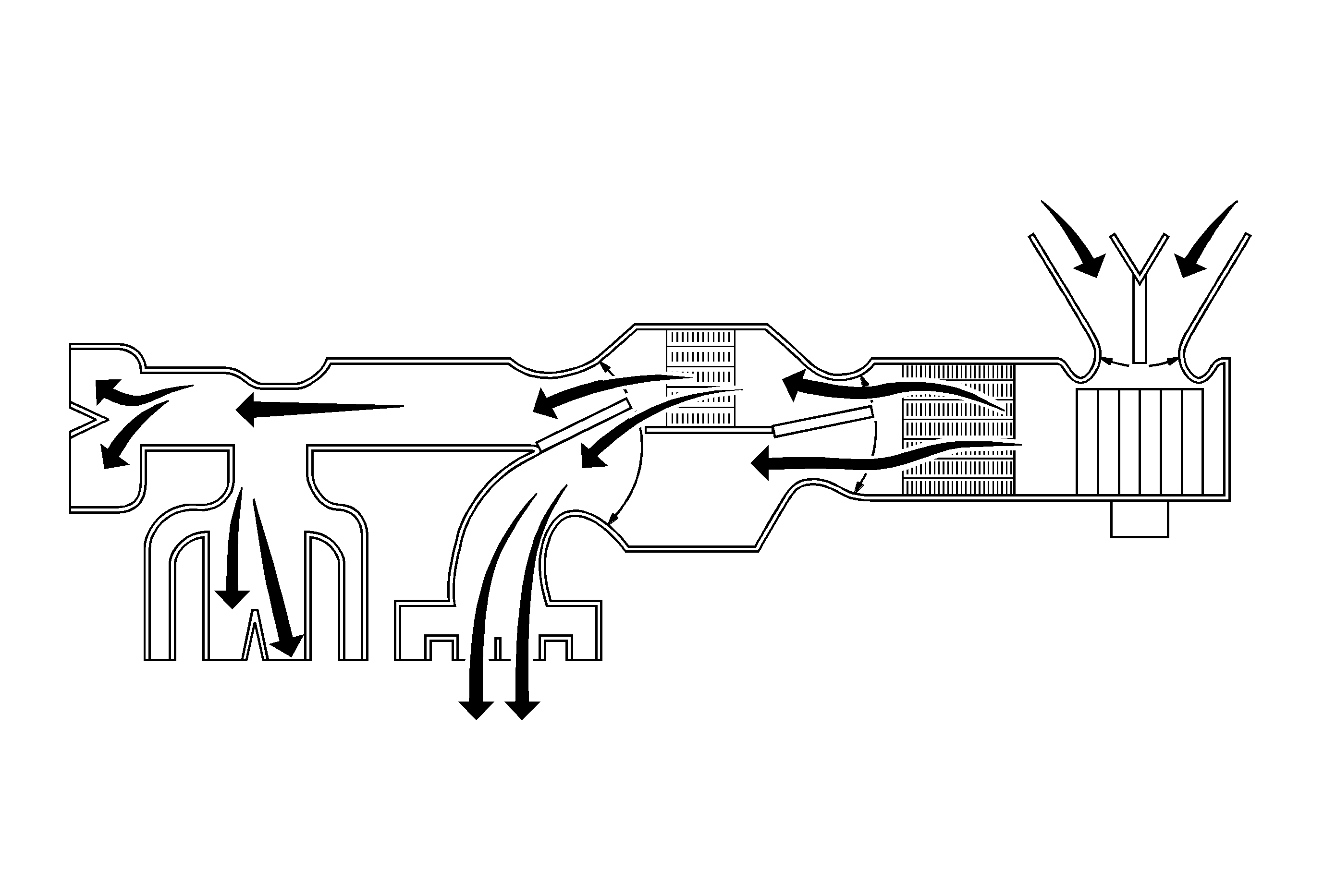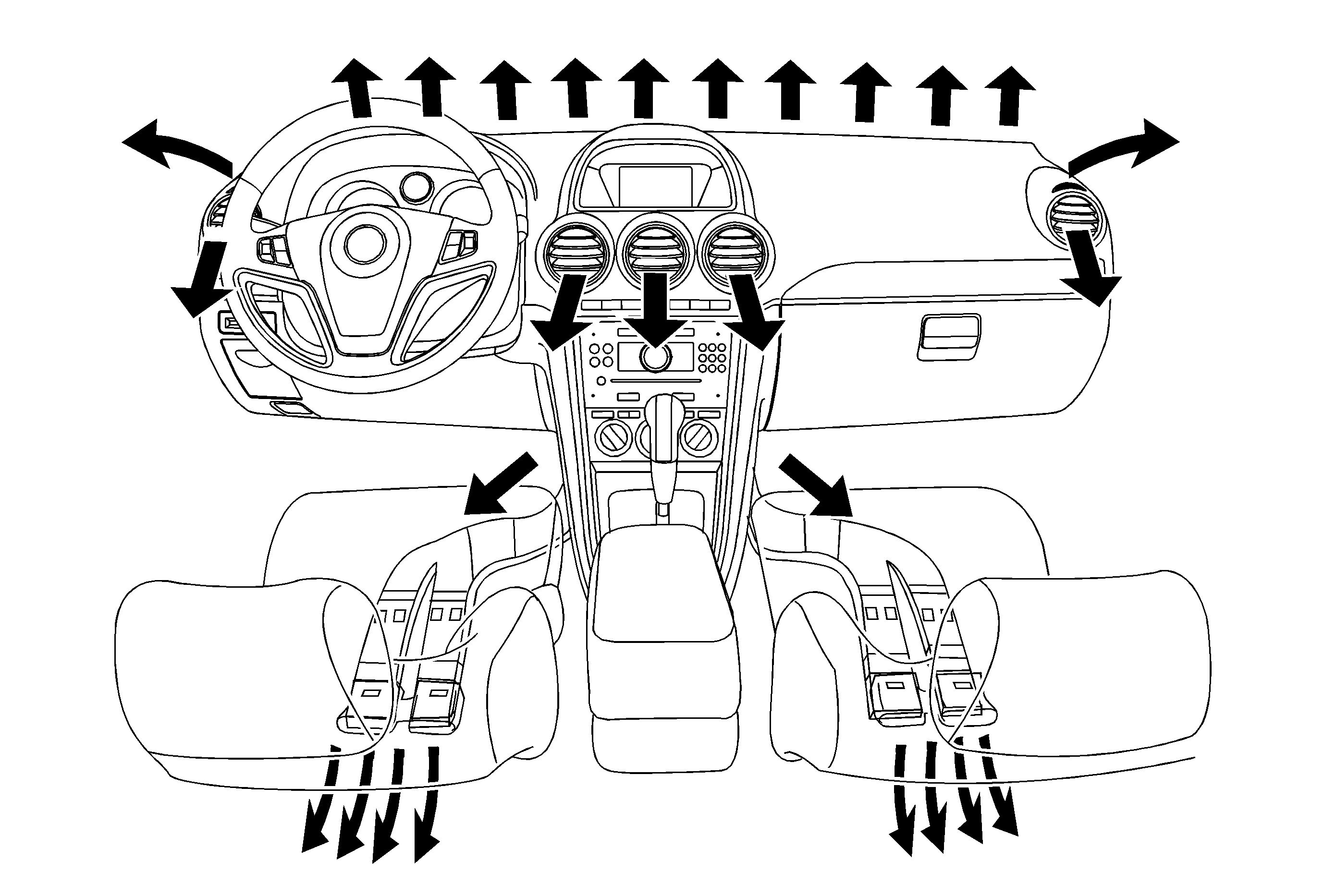The base heater system is designed to provide heating, ventilation, windshield defrosting, side window defogging, and some vehicles, heating directly to the rear seat area.
The heater and fan assembly blower regulates the airflow from the air inlet for further processing and distribution.
The heater core transfers the heat from the engine coolant to the inlet air.
The temperature door regulates the amount of the air that passes through the heater core. The temperature door also controls the temperature of the air by controlling the mix of the heated air and the ambient air.
The mode door regulates the flow and the distribution of the processed air to the heater ducts and to the defroster ducts.
This console-mounted heating and ventilation panel contains the following:
- The Rotary Temperature Control Knob
- The Rotary Blower Control Knob
- The Rotary Mode Control Knob
| • | Actuates by cable. |
| • | Raises the temperature of the air entering the vehicle by rotation toward the right, or the red portion of the knob. |
| • | Turns on to operate the blower motor at four speeds. |
| • | Turns OFF to stop the blower. |
| • | Operates completely independently both from the mode control that regulates the defroster door and from the temperature control knob. |
| • | Changes the fan speed in any mode and at any temperature setting. |
| • | Actuates by electrical motor. |
| • | Regulates the air distribution between the windshield, the instrument panel, and the floor vents. |
The A/C Push Button
If the vehicle is equipped with air conditioning:
| • | Controls the A/C. |
| • | Turns the A/C ON when the push knob is down. However, if the blower control knob is OFF, the A/C system is OFF, regardless of the position of the A/C knob. |
The Fresh Air Control
| • | Operates by electrical motor. |
| • | Draws in outside air when knob is off. |
| • | Recirculates inside air when the knob is down and the indicator lamp is illuminated. |
Airflow - Typical

Airflow with Rear Heating Duct (Left Hand Drive Shown, Right Hand Drive Similar)

The base heater system is designed to provide heating, ventilation, windshield defrosting, side window defogging, and some vehicles, heating directly to the rear seat area.
The heater and fan assembly blower regulates the airflow from the air inlet for further processing and distribution.
The heater core transfers the heat from the engine coolant to the inlet air.
The temperature door regulates the amount of the air that passes through the heater core. The temperature door also controls the temperature of the air by controlling the mix of the heated air and the ambient air.
The mode door regulates the flow and the distribution of the processed air to the heater ducts and to the defroster ducts.
This console-mounted heating and ventilation panel contains the following:
- The Rotary Temperature Control Knob
- The Rotary Blower Control Knob
- The Rotary Mode Control Knob
| • | Actuates by cable. |
| • | Raises the temperature of the air entering the vehicle by rotation toward the right, or the red portion of the knob. |
| • | Turns on to operate the blower motor at four speeds. |
| • | Turns OFF to stop the blower. |
| • | Operates completely independently both from the mode control that regulates the defroster door and from the temperature control knob. |
| • | Changes the fan speed in any mode and at any temperature setting. |
| • | Actuates by electrical motor. |
| • | Regulates the air distribution between the windshield, the instrument panel, and the floor vents. |
The A/C Push Button
If the vehicle is equipped with air conditioning:
| • | Controls the A/C. |
| • | Turns the A/C ON when the push knob is down. However, if the blower control knob is OFF, the A/C system is OFF, regardless of the position of the A/C knob. |
The Fresh Air Control
| • | Operates by electrical motor. |
| • | Draws in outside air when knob is off. |
| • | Recirculates inside air when the knob is down and the indicator lamp is illuminated. |
Airflow - Typical

Airflow with Rear Heating Duct (Left Hand Drive Shown, Right Hand Drive Similar)

The SP-17 A/C System
The SP-17 is a fixed 173 cc displacement swash plate compressor. It consists of five double-ended pistons reciprocated in 10 cylinder bores by the swash plate and shaft assembly. There are 10 hemispheric shoes connecting the pistons to the swash plate and shaft assembly. As the swash plate rotates, the shoes swivel. Thus the rotary motion of the swash plate is converted to the reciprocating motion of the pistons.
Compressor
The SP-17 compressor is belt-driven from the engine crankshaft through the compressor clutch pulley. The compressor pulley rotates without driving the compressor shaft until an electromagnetic clutch coil is energized. When voltage is applied to energize the clutch coil, the clutch plate and hub assembly is drawn rearward toward the pulley. The magnetic force locks the clutch plate and pulley together as one unit to drive the compressor shaft.
As the compressor shaft is driven, it compresses the low - pressure refrigerant vapour from the evaporator into a high-pressure, high-temperature vapor. The refrigerant oil which is used to lubricate the compressor is carried with the refrigerant..
Pressure Relief Valve
The compressor is equipped with a pressure relief valve which is placed in the system as a safety factor. Under certain conditions, the refrigerant on the discharge side may exceed the designed operating pressure. In order to prevent system damage, the valve is designed to open automatically at approximately 3 171 to 4 137 kPa (460 to 600 psi) in an R-134a system. Conditions that might cause this valve to open, such as a defective pressure transducer, an inoperative cooling fan, etc., should be corrected. The refrigerant oil and the refrigerant should be replaced as necessary.
Condenser Core
The condenser assembly in front of the radiator consists of coils which carry the refrigerant, and cooling fins that provide the rapid transfer of heat. The air passing through the condenser cools the high-pressure refrigerant vapor and causes it to condense into a liquid.
Expansion Valve
The expansion valve can fail in three different positions: open, closed, or restricted.
An expansion valve that fails in the open position will result in a noisy A/C compressor or no cooling. The cause can be a broken spring, a broken ball, or excessive moisture in the A/C system. If the spring or the ball are found to be defective, replace the expansion valve. If excessive moisture is found in the A/C system, recycle the refrigerant.
An expansion valve that fails in the closed position will result in low suction pressure and no cooling. This may be caused by a failed power dome or excessive moisture in the A/C system. If the power dome on the expansion valve is found to be defective, replace the expansion valve. If excessive moisture is found in the A/C system, recycle the refrigerant.
A restricted expansion valve will result in low suction pressure and no cooling. This may be caused by debris in the refrigerant system. If debris is believed to be the cause, recycle the refrigerant, replace the expansion valve, and replace the receiver-dryer.
Evaporator Core
The evaporator is a device which cools and dehumidifies the air before it enters the vehicle. High-pressure liquid refrigerant flows through the expansion tube orifice and becomes a low-pressure gas in the evaporator. The heat in the air passing through the evaporator core is transferred to the cooler surface of the core, which cools the air. As the process of heat transfer from the air to the evaporator core surface is taking place, any moisture or humidity in the air condenses on the outside surface of the evaporator core and is drained off as water.
Receiver-Dryer
The sealed receiver-dryer assembly is connected to the condenser outlet pipe. It acts as a refrigerant storing container, providing liquid, vapor, and refrigerant oil to the evaporator.
At the bottom of the receiver-dryer is the desiccant, which acts as a drying agent for the moisture that may have entered the system.
Heater Core
The heater core heats the air before it enters the vehicle. Engine coolant is circulated through the core to heat the outside air passing over the fins of the core. The core is functional at all times and may be used to temper conditioned air in the A/C mode as well as in the heat or the vent modes.
Pressure Transducer
Pressure transducer switching incorporates the functions of the high-pressure and the low-pressure cutout switches along with the fan cycling switch. The pressure transducer is located in the high-side liquid refrigerant line behind the right headlamp, between the right front inner fender and the air filter assembly. The output from this pressure transducer goes to the engine control module (ECM) which controls the compressor function based on the pressure signal.
Wide Open Throttle (WOT) Compressor Cutoff
During full throttle acceleration, the throttle position sensor (TPS) sends a signal to the engine control module (ECM), which then controls the compressor clutch. It is not uncommon for the ECM to temporarily disable the SP-17 compressor, to save from overloading the A/C system, and increase engine output ability.
Auxiliary Evaporator Core
The auxiliary evaporator is located within the auxiliary HVAC module, behind the rear quarter trim panel, adjacent to the luggage compartment of the vehicle. The auxiliary evaporator core cools and dehumidifies the air after being cycled through the auxiliary blower motor. High-pressure liquid refrigerant flows through the expansion tube orifice and becomes a low-pressure gas in the evaporator. The heat in the air passing through the evaporator core is transferred to the cooler surface of the core, which cools the air. As the process of heat transfer from the air to the evaporator core surface is taking place, any moisture or humidity in the air condenses on the outside surface of the evaporator core and is drained off as water.
Auxiliary Expansion Valve
The auxiliary expansion valve is located within the rear auxiliary HVAC module, and is located on the return side of the auxiliary evaporator core.
The auxiliary expansion valve can fail in three different positions: open, closed, or restricted.
An auxiliary expansion valve that fails in the open position will result in a noisy A/C compressor or no cooling. The cause can be a broken spring, a broken ball, or excessive moisture in the A/C system. If the spring or the ball are found to be defective, replace the auxiliary expansion valve. If excessive moisture is found in the A/C system, recycle the refrigerant.
An auxiliary expansion valve that fails in the closed position will result in low suction pressure and no cooling. This may be caused by a failed power dome or excessive moisture in the auxiliary A/C system. If the power dome on the auxiliary expansion valve is found to be defective, replace the auxiliary expansion valve. If excessive moisture is found in the auxiliary A/C system, recycle the refrigerant.
A restricted expansion valve will result in low suction pressure and no cooling. This may be caused by debris in the refrigerant system. If debris is believed to be the cause, recycle the refrigerant, replace the auxiliary expansion valve, and replace the receiver-dryer.
